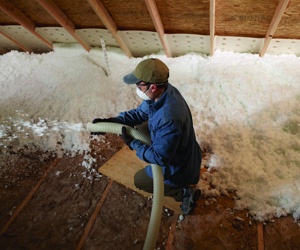You don’t have to live in Florida to know it gets hot. Did you know that during the summer your rooftop can reach up to 140°F? That heat doesn’t stay on your roof. It radiates down into your attic, through the attic floor, and into your home. Without proper insulation, your energy bills climb as your AC works overtime to fight off the heat pouring through your attic floor while your conditioned air easily rises through your attic floor and out of your roof.
The ceiling of your upper floor (also known as your attic floor), is where the most heat enters your home. More heat moves through your ceiling than through any other part of your house. That’s why choosing the right attic insulation matters.
Florida’s Extreme Heat Challenge
Cooling and heating use up an average of 52% of the energy in a typical American home. But a well-insulated attic can dramatically lower that number by reducing energy consumption and improving comfort. It’s one of the easiest and most cost-effective ways to boost your home’s efficiency. In fact, the Florida Department of Agriculture and Consumer Services calls attic insulation “the most important location and best return on investment” for improving energy efficiency.
 But humidity and air leakage also play a part. Not only is heat passing through your attic, but hot, moist air leaks in as well through attic gaps to make your AC work overtime and possibly create condensation issues. These problems can be taken care of with proper insulation and air sealing. They work together to lower your cooling costs, improve your indoor comfort, and protect your home.
But humidity and air leakage also play a part. Not only is heat passing through your attic, but hot, moist air leaks in as well through attic gaps to make your AC work overtime and possibly create condensation issues. These problems can be taken care of with proper insulation and air sealing. They work together to lower your cooling costs, improve your indoor comfort, and protect your home.
New homes in Florida must meet current state building codes for energy efficiency. The current code requires Tallahassee attics to have a minimum R-value of R-38 of insulation installed for our climate zone, which is climate zone 2. Many older homes in our community fall short of this standard and would greatly benefit from adding insulation. You can check your level of attic insulation or schedule a professional home energy audit to find out if you need more insulation.
Common Attic Insulation Methods for Florida Homes
There are three main types of attic insulation installation method used in Florida: blown-in insulation, blown-in insulation with air sealing, and spray foam insulation. Here’s some more information about each one.
Blown-In Insulation
Insulating your attic with blown-in insulation is a quick and easy way to add R-value. Loose fill insulation, made from fiberglass or cellulose insulation, is blown across your attic floor to create a thick blanket of coverage that doesn’t settle much over time. It’s great for retrofitting because it can be added over your existing clean insulation. It’s also affordable, fills oddly shaped spaces easily, is non-combustible, and won’t attract pests.
With an R-value of 2.2-2.9 per inch for fiberglass and 3.1-3.8 per inch for cellulose, you’ll need approximately 12 to 13 inches of insulation to reach an R-value of R-38.
However, blown-in fiberglass and cellulose do not completely stop air leaks on their own. Warm air can still move through unsealed cracks. That’s where air sealing comes in.
Blown-In Insulation with Air Sealing
Combining blown-in insulation with air sealing dramatically increases your home’s energy efficiency. Air sealing closes gaps, cracks, and penetrations between your living space and your attic, especially around pipes, wires, and light fixtures. It helps prevent hot, humid air from sneaking in and keeps your home’s cooled air from escaping. The result is not only better energy efficiency and less strain on your HVAC system, but also reduced moisture, and fewer problems with mold growth.
It’s recommended that air sealing be your first step before adding insulation (You may have to remove old insulation before air sealing an existing attic). Be sure that all openings and cracks are sealed with foam and your attic access door with weatherstripping. After air sealing is complete, a fresh blanket of blown-in insulation is installed.
Spray Foam Insulation for a Sealed, Unvented Attic
 Spray foam insulation is the only type of insulation that seals and insulates at the same time, creating a sealed attic space that stays much cooler than traditional vented attics. It is applied directly to the underside of your roof deck and rafters, where it expands and hardens to form a continuous insulation layer and seal air leaks. This helps keep out humid air and creates a drier, more controlled attic environment that reduces condensation on attic ducts and wood surfaces. You’ll also enjoy cooler bedrooms, less stress on your AC unit, and added structural strength to your roof.
Spray foam insulation is the only type of insulation that seals and insulates at the same time, creating a sealed attic space that stays much cooler than traditional vented attics. It is applied directly to the underside of your roof deck and rafters, where it expands and hardens to form a continuous insulation layer and seal air leaks. This helps keep out humid air and creates a drier, more controlled attic environment that reduces condensation on attic ducts and wood surfaces. You’ll also enjoy cooler bedrooms, less stress on your AC unit, and added structural strength to your roof.
There are two types of spray foam: open-cell and closed-cell. They both offer a higher R-value than other types of insulation, allowing you to achieve a higher insulation level without the thickness of other products. Closed-cell spray foam is denser than open-cell spray foam and offers better moisture control.
Spray foam application requires professional installation. While spray foam is more expensive than other insulation options, it’s one of the most effective ways to insulate your Florida attic. Check out the Florida Building Code or talk with a professional for the most up-to-date information on insulating and air sealing an unvented attic with spray foam.
Attic Insulation Best Practices in Florida
These tips will help ensure your attic is properly insulated and air sealed for many years to come.
- Seal leaks and gaps in your attic floor before you insulate.
- Keep soffit vents and eave vents clear to maintain airflow in vented attics.
- Be careful not to compress your insulation and make sure it’s evenly distributed, without gaps, for maximum effectiveness.
- Insulate and air seal your attic access door.
- Use the right type of insulation for your attic layout: loose fill insulation is ideal for open attics while spray foam insulation is great for sealed attics. Always follow local building codes.
- Check your insulation regularly, especially after storms, for signs of moisture, pests, or damage.
- It’s always best to leave the job in the hands of a professional for proper installation.
Your Florida Partner in Energy Efficiency
 Having a well-insulated and air sealed attic is essential for energy savings and comfort in the Sunshine State. It helps your AC run less, keeps your home cooler, saves money on your energy bills, and conserves energy for a healthier environment.
Having a well-insulated and air sealed attic is essential for energy savings and comfort in the Sunshine State. It helps your AC run less, keeps your home cooler, saves money on your energy bills, and conserves energy for a healthier environment.
Wondering if your home needs more insulation? Don’t wait for another blistering summer to drain your wallet. Ensure your home is ready for every Florida “season” with properly installed attic insulation and air sealing. At Allweather Insulation, we’ve been insulating new and existing Tallahassee homes since 1955 and are experts in energy efficiency, insulation installation, and our local climate. You can count on us for tailored insulation solutions to maximize your home’s energy efficiency and comfort. Contact us today to schedule your free estimate and start enjoying the benefits of a well-insulated home.
References
University of Central Florida Energy Research. (n.d.). Attic insulation and ventilation. UCF Energy Research. https://energyresearch.ucf.edu/research/buildings-research/roof-assembly/attic-insulation-ventilation/
University of Florida IFAS Extension. (n.d.). Building green: Whole-house systems approach. UF/IFAS Extension. https://buildgreen.ifas.ufl.edu/IST%20Materials%20for%20Agents/Taylor_Whole-House_Systems_Approach_Handout.pdf
University of Florida IFAS Extension. (n.d.). Energy insulation. Living Green. https://livinggreen.ifas.ufl.edu/topics/energy/insulation/
Florida Department of Agriculture and Consumer Services. (n.d.). Weatherization: Insulation. My Florida Home Energy. https://www.myfloridahomeenergy.com/help/library/weatherization/insulation/

